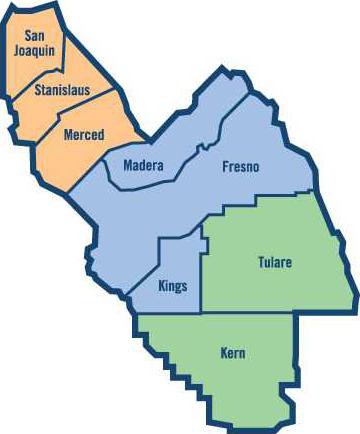The Northern San Joaquin Valley – San Joaquin, Stanislaus and Merced counties – was the fastest growing region in California from July 2016 through June 2017.
The 209 grew at twice the rate as the state as a whole. Placer County in the Sacramento area was the fastest growing county with a 1.56 percent jump in population followed by Stanislaus and Merced counties tied at second at 1.47 percent followed by San Joaquin County at 1.46 percent. Rounding out the top five were Riverside County at 1.28 percent and Yolo County at 1.27 percent.
The three Northern San Joaquin Valley counties added 22,703 residents as of July 1, 2017. That was almost 700 more than Lathrop’s population of 22,073 on the first day of 2016. A tenth of the 2016-2017 population growth in the three counties was concentrated in Manteca and Lathrop. San Joaquin added 10,749 residents, Stanislaus 7,965, and Merced 3,989.
The 209 as of July 1 had 1,576,924 residents with almost half or 749,092 residents in San Joaquin County. Stanislaus County was at 551,557 and Merced County at 276,275.
If the Northern San Joaquin Valley were a separate state it would rank 40th based on population. It would be ahead of Hawaii, New Hampshire, Maine, Rhode Island, Montana, Delaware, South Dakota, North Dakota, Alaska, Vermont and Wyoming plus the District of Columbia.
The Department of Finance numbers released Thursday put California’s overall population on July 1 at 39,613,045 up 300,816 or 0.77 percent from the previous year. If the pace continues through June 30, California will be 139 residents shy of 40 million people on July 1, 2018.
The demographic data shows the 209 bucking two key state trends. Statewide domestic immigration has seen more people move out of California – 105,210 – than move in from other states. That trend started in 2009 with outward migration at 29,972 and peaking at 163,992 in 2016. The state had a net foreign immigration gain of 185,429 and a net migration overall of 80.219 compared to 485,622 births.
All three 209 counties had more domestic immigration – whether from within California or elsewhere in the United States than foreign immigration. The numbers were:
San Joaquin County: Net migration, 6,182; net foreign migration, 2,896; net domestic migration, 3,286.
Stanislaus County: Net migration, 4,526; net foreign migration, 1,184; net domestic migration, 2,686.
Merced County: Net migration, 1,737; net foreign migration, 699; net domestic migration, 1,038.
The other area where the 209 bucks state trends is the growth in the death rate. There was an increase of 5,291 deaths – 1.9 percent – to reach 259,739 for the 12-month period ending June 30, 2017. San Joaquin had 10,125 deaths for an increase of 51 or 0.5 percent over the previous year. Stanislaus had 7,758 deaths for an increase of 59 or 0.76 percent. Merced had 4,081 deaths for an increase of 6 or 0.14 percent.
The lower mortality rate is typically reflective of the average age of a county’s population. That would dovetail with studies that have shown San Joaquin County, as an example, is dropping in median age and will continue to do so for at least the next decade.
California's counties range in size from 10.3 million in Los Angeles, which is larger than most states, to tiny Alpine with just 1,141 people – nine fewer than a year ago.
The largest numeric increases were in the Southern California counties of Los Angeles, Riverside, San Diego, Orange and San Bernardino, where each grew by more than 20,000 people. The biggest percentage jumps were in the Sacramento suburbs, the Inland Empire outside Los Angeles and the Central Valley.
Thirteen counties shrank, most of them sparsely populated areas in far Northern California and the Sierra Nevada range. Marin County, which includes wealthy San Francisco suburbs north of the Golden Gate Bridge, lost 161 people.
Nine counties with more than 1 million people each comprise 70 percent of the state’s population. They include the cities and suburbs of Los Angeles, San Diego and Sacramento as well as Silicon Valley and the East Bay outside San Francisco.
The city population numbers will be released in May.
The last cities report based on population as of Jan. 1, 2016 showed that the fastest growing area in the Northern San Joaquin Valley is South San Joaquin County and the five cities whose economies are becoming more tied into the Bay Area via freeway umbilical cords with each passing year.
The cities of Manteca, Tracy, Lathrop, and Ripon added 4,241 residents in 2016. The four cities have a combined population of 205,379 or 9,701 less than Modesto’s 215,080 residents that rank as California’s 19th largest city. Stockton is the largest city in the Northern San Joaquin Valley and 13th statewide with 320,564 people.
Based on the May 2016 state report, Lathrop was the fifth fastest growing city in California percentage wide growing 4.2 percent by adding 936 residents. Menlo Park topped the list with an annual growth rate of 5.5 percent.
In terms of actual residents added, four of the top 50 cities for growth were in the Northern San Joaquin Valley. Stockton was 10th with 4,090 new residents, Modesto 20th with 2,793 more residents, Manteca was 33rd with 2,025 more residents, and Tracy was 48th with 1,429 more residents, Los Angeles topped the list, growing by 42,470 as it broke the four million mark with a population of 4,041,707.
Manteca is now the 112th largest city out of 482 statewide. Manteca at its current growth rate will top 80,000 residents in 2018. If that happens, Manteca will have doubled in size in 18 years. The city’s population in 1990 was 40,773 residents.
Lathrop at its current growth rate will top 25,000 residents in 2018. Ripon at its current growth rate will top 17,000 residents in 2020.
The top 10 cities in the entire 209 region including valley and foothill cities are, in descending order, Stockton, Modesto, Tracy, Merced, Manteca, Turlock, Lodi, Ceres, Los Banos and Atwater.





